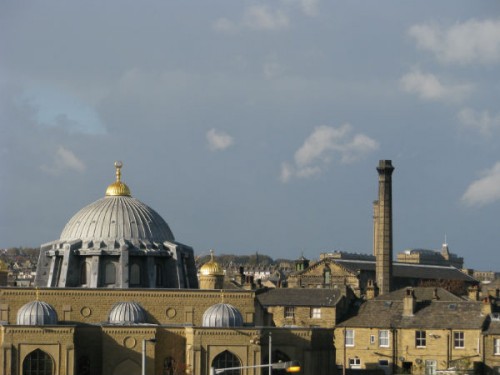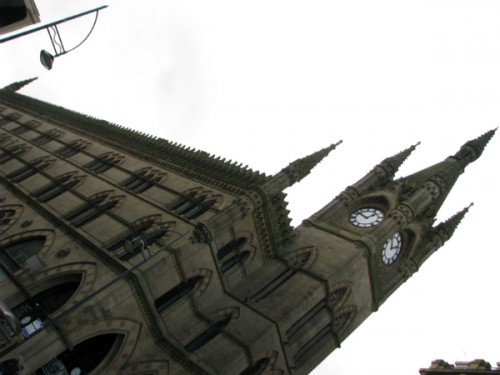Local Renaissance man, Walter Grumpius, wonders if Bradford could possibly match the conditions of a certain historical event that happened ages ago in a nation now more famous for football …
Much has happened in Bradford in the cause of regeneration, and more recently the word renaissance has been bandied about.
Renaissance vibrates with so much more intensity and positivity, a compelling call-to-arms rather than the limp ‘regeneration’ which has a worthy corporate air to it, redolent of think tanks, focus groups, sub-committees and interim reports that galvanise few, if any, with the necessary propulsive enthusiasm.
Renaissance on the other hand implies a fresh way of looking at things that can be embraced by everyone and energise simultaneously. So let’s talk about renaissance; indeed, let’s talk about The Renaissance – the historical one that happened five, six, seven centuries ago in Italy and northern Europe. What was it predicated on and do similar conditions obtain in Bradford today? And, if not, are there still lessons we can take from it?
First, the political conditions. Essentially it was a world of city-states; nations as we know them today – and more particularly national governments – simply didn’t exist. Decisions were taken at the civic level and political practice tended much more to the roots of the word, from the Greek ‘polis’ meaning ‘city’. Florence did what Florence wanted to do, and the same with Venice, Milan, Bruges, Ghent and so on. There was civic pride and enthusiasm and there was competition between the cities to outdo each other with civic display. There was rarely what we would recognise as democracy but there was much popular involvement through the tightly organised trade guilds. The important point was that the city itself was the power and its citizens felt closer to the hub and heart of the matter.
Secondly, the economic conditions. The prosperous cities of the Italian peninsula and northern Europe based their wealth on the growth of the cloth industry and the related commerce that ensued, together with the banking services that developed to accommodate this growth. Some individuals and families became very rich indeed and were willing to make a stake for local influence, popularity and power by pouring money into public works for the city, and into the art to adorn the resultant buildings. The trade guilds also vied with each other by commissioning works of public sculpture to illustrate their trades. Nor should a gentle nudge from the powerful clergy to rich men, with messages about camels and eyes of needles, be discounted in the redirection of wealth to the construction of prominent cathedrals and churches and the art that adorned them in the way of altarpieces and frescoes.
Thirdly – and essentially – let’s look at the cultural conditions. The requirements of industry and trade, and the banking and legal services that developed alongside necessitated a change in the kind of education available. A more rounded scholar was required. The result was students with deeply enquiring minds, who recovered the learning and culture of ancient Greece and Rome and applied it to their contemporary world in innovative and stimulating ways. The Renaissance coincided with the birth and growth of the mendicant orders such as the Franciscans and Dominicans who, amongst other works, tended to the spiritual and other needs of the poorer groups – in particular the many individuals attracted to the cities from the countryside to work in the cloth industry. Churches were built to accommodate this new congregation. Building, as a self-generator of renaissance, cannot be underestimated. And of course there were the geniuses and the merely highly talented who emerged to build the iconic cathedrals and civic buildings and to decorate them with sculptures and paintings.
This brief overview does considerable violence to the complexity of the Renaissance but the main points would seem to be: power at the city level; disposable wealth aimed at civic projects; and the talented individuals to grasp the opportunities afforded.
Do these conditions obtain in Bradford today? It is difficult not to be pessimistic in contemplating an answer. These conditions certainly existed in 19th century Bradford. The textile trade was in the ascendancy, wealth was there, and the city fathers were little troubled by Westminster as they developed Bradford; they could call in a man like John Ruskin to advise on what sort of building the Wool Exchange should be, and had the architects to build the mills, the Town Hall, St George’s Hall, Little Germany, Kirkgate Market, Saltaire and on and on; a snowball of buildings, one generating another. But that was then.
Can we hope for another “renaissance” in the 21st century? Let’s take the talent as a given, but the other pointers are absent. There doesn’t appear to be the brass, therefore visions of even small-scale transformations of the cityscape seem farfetched at the moment. Central government is more intrusive. Civic governance seems hamstrung; the Westfield Hole a daily indictment. This is why, perhaps quixotically, I voted in favour of an elected Mayor in this year’s referendum. Might not a charismatic individual – assuming one such were elected – bring the kind of energy and fresh thinking needed to inspire hole-filling and a Bradfordian renaissance? We shall never know.
But let’s not end on a pessimistic note. Let’s look at Leeds. (OK, sorry, just for a moment!) In that city there is the money, there is the will, there is the way. Not all the buildings that have gone up in the flurry of building over the last two decades are aesthetically pleasing but they are nearly all imaginative and evidence of creative confidence, and they have given a buzz to the city, a sort of can-do mentality which has conquered inertia. So if we can get something exciting and inspirational built on the Westfield site and have another fabulous inclusive opening like the one for City Park, the self-generating factor may well kick in.
But in the meantime, small beginnings: the City Park itself of course, but also a personal experience from several months ago. It was a winter Sunday and I had gone into central Bradford with the intention of visiting the Impressions Gallery and then having a drink at the justly feted Sparrow Bier Café. And the outcome: both closed! A holiday, a day you can go out and do things, and only frustration. To be scrupulously fair the Sparrow has since rectified this.
I was beginning to despair when out of the corner of my eye, past the increasingly desolate Odeon building, I caught an attractive flash of red along Thornton Road. I made a beeline for it and it turned out to be Culture Fusion. And what a lift to the spirits it caused. Clearly in evidence in this design is a mixture of energy, imagination, love, and faith in the future. What a joy for the Bradford skyline. It can be done. More of it and the renaissance will gradually create a momentum of its own.


An excellent post on Bradford’s past and future.
‘Renaissance’ gets banded about too often, IMHO, and is in danger of becoming a cliche.
In Bradford’s case, I think culturally the Council are beginning to see that they should not see themselves as the be all and end all, and Susan Hinchcliffe (Portfolio: Culture et al) wants to see Bradford artists and others taking a lead on what’s shown (http://tinyurl.com/cpctfd3). Gideon Seymour of Fabric & Hand Made in Bradford also wants the Council to invest in local talent and believes we should have people with a BD postcode being the main event at big City Park shindigs.
As for the erstwhile benefactors, we need a new generation of these. One idea that has been put across on Twitter is to build us as a dotcom start up city, with excellent connectivity, a central location, excellent motorway access and cheap rent, it could be that Bradford’s brass is made in the ether, with a new breed of millionaires driving forward technology, just as the last generation of them did. But I think that’s a huge ask.
Finally, Westfield – spot on! If it can bring people (particularly middle-class from the Aire & Wharfe valleys), the potential for other businesses to spring up around it and spread back into the city is enormous.
Thanks for posting – really enjoyed it.
Interesting. Nice that the city states that fascinated 19th century anarchists still have a pull these days.
But I don’t know why you’re so downhearted about the future.
Bradford WILL be getting an elected mayor. It’s just that she’ll be called the Mayor of Leeds City Region (of which Bradford is a part). Or Mayor of Leeds for short.
And that mayor will spearhead the drive for the investment needed for your hole-filling and renaissance-bringing. While we await the mayor’s coming, there’s a top-level delegation off to an international investment beanfeast in Cannes in March to showcase “the best of the Leeds City Region”(http://bitly.com/Pvx7sx). They’re bound to come home with cash for Bradford, aren’t they?
And you haven’t mentioned the city region’s Local Enterprise Partnership. Its members are the savviest local business and council leaders – from Ripon to Pontefract, Skipton to Barnsley and all points in between – and any year soon now they’re going to be starting to dole out the government cash needed for Bradford to grow.
Who knows? If Bradford is really lucky it could see the enterprise partnership morph into a re-born regional development agency like Yorkshire Forward. They’d certainly be up for helping to “generate the renaissance” of the city by … erm … “investing” in the odd iconic building or two. (http://bit.ly/GEB6OT)
Chin up!
PS the shiny building renaissance of Leeds has been great for growth in the chorizo bar sector, but the jury’s out on what it has achieved for people living less than a mile away in the “doughnut of despair” and beyond.
Are people talking about a Rennaissance? I’ve not heard it seriously used. A few green and tender shoots of potential are appearing but no more, surely?
Walter’s point about trade is a crucial one. What will Bradford be selling? Dot coms and broadband are not the answer of themselves, how are we supporting people to think the new things/operate in the new ways that are demanded by the knowledge economy? How do we build the support structures that allow for risk and failure (many successful businesses are born from the ashes of previous failure)?
I can understand the model outlined in Gideon’s desire to get BD artists making the big work in City Park, it’s not really a solution to anything. We need to make sure that BD artists are making that work in Birmingham, Brighton, Cardiff but finding the making of it easier, more supportive and viable in Bradford. And getting people relocating here because of that.
And for art read anything.